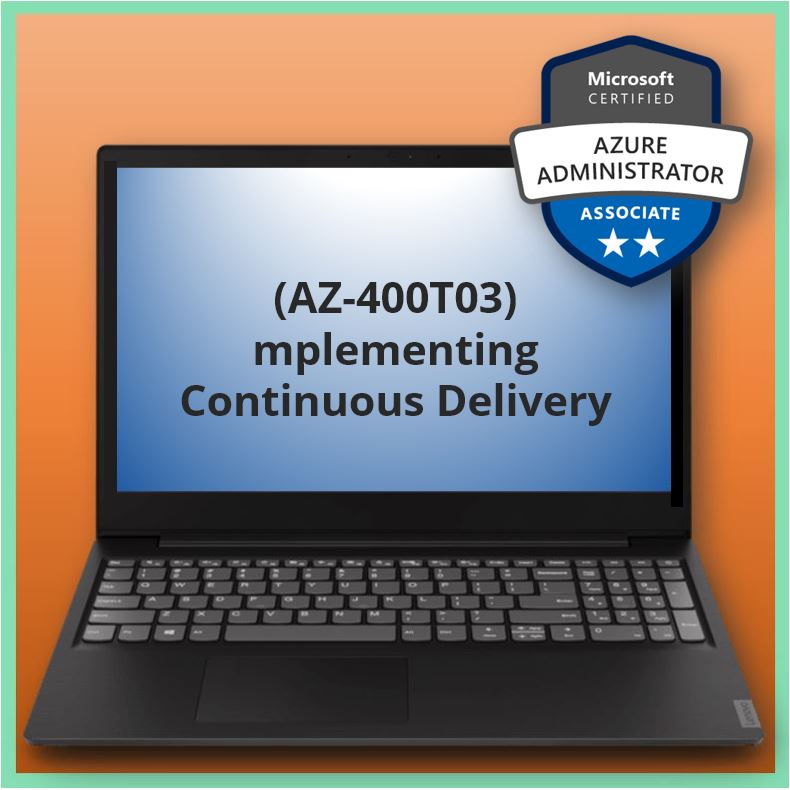Aangeboden leervormen

Implementing Continuous Delivery (AZ-400T03)
This course provides the knowledge and skills to implement continuous delivery. Students will learn how to design a release strategy, set up a release management workflow, and implement an appropriate deployment pattern.
After completing this course, students will be able to:
• Differentiate between a release and a deployment
• Define the components of a release pipeline
• Explain things to consider when designing your release strategy
• Classify a release versus a release process, and outline how to control the quality of both
• Describe the principle of release gates and how to deal with release notes and documentation
• Explain deployment patterns, both in the traditional sense and in the modern sense
• Choose a release management tool
• Explain the terminology used in Azure DevOps and other Release Management Tooling
• Describe what a Build and Release task is, what it can do, and some available deployment tasks
• Classify an Agent, Agent Queue and Agent Pool
• Explain why you sometimes need multiple release jobs in one release pipeline
• Differentiate between multi-agent and multi-configuration release job
• Use release variables and stage variables in your release pipeline
• Deploy to an environment securely, using a service connection
• Embed testing in the pipeline
• List the different ways to inspect the health of your pipeline and release by using, alerts, service hooks and reports
• Create a release gate
• Describe deployment patterns
• Implement Blue Green Deployment
• Implement Canary Release
• Implement Progressive Exposure Deployment

Voor wie
Programma
Module 1: Design a Release Strategy
Lessons
• Introduction to Continuous Delivery
• Release strategy recommendations
• Building a High Quality Release pipeline
• Choosing a deployment pattern
• Choosing the right release management tool
Lab : Building a release strategy
After completing this module, students will be able to:
• Differentiate between a release and a deployment
• Define the components of a release pipeline
• Explain things to consider when designing your release strategy
• Classify a release versus a release process, and outline how to control the quality of both
• Describe the principle of release gates and how to deal with release notes and documentation
• Explain deployment patterns, both in the traditional sense and in the modern sense
• Choose a release management tool
Module 2: Set up a Release Management Workflow
Lessons
• Create a Release Pipeline
• Provision and Configure Environments
• Manage And Modularize Tasks and Templates
• Integrate Secrets with the release pipeline
• Configure Automated Integration and Functional Test Automation
• Automate Inspection of Health
Lab : Automating your infrastructure deployments in the Cloud with Terraform and Azure Pipelines
Lab : Setting up secrets in the pipeline with Azure Key vault
Lab : Setting up and Running Load Tests
Lab : Setting up and Running Functional Tests
Lab : Using Azure Monitor as release gate
Lab : Creating a Release Dashboard
After completing this module, students will be able to:
• Explain the terminology used in Azure DevOps and other Release Management Tooling
• Describe what a Build and Release task is, what it can do, and some available deployment tasks
• Classify an Agent, Agent Queue and Agent Pool
• Explain why you sometimes need multiple release jobs in one release pipeline
• Differentiate between multi-agent and multi-configuration release job
• Use release variables and stage variables in your release pipeline
• Deploy to an environment securely, using a service connection
• Embed testing in the pipeline
• List the different ways to inspect the health of your pipeline and release by using, alerts, service hooks and reports
• Create a release gate
Module 3: Implement an appropriate deployment pattern
Lessons
• Introduction into Deployment Patterns
• Implement Blue Green Deployment
• Feature Toggles
• Canary Releases
• Dark Launching
• AB Testing
• Progressive Exposure Deployment
Lab : Blue-Green Deployments
Lab : Traffic Manager
After completing this module, students will be able to:
• Describe deployment patterns
• Implement Blue Green Deployment
• Implement Canary Release
• Implement Progressive Exposure Deployment
Voorkennis
Fundamental knowledge about Azure, version control, Agile software development, and core software development principles. It would be helpful to have experience in an organization that delivers software.
Examen
MICROSOFT AZ-400
De volgende trainingen (inclusief deze) zijn nodig als voorbereiding voor het examen
AZ-400T01: Implementing DevOps Development Processes
AZ-400T02: Implementing Continuous Integration
AZ-400T03: Implementing Continuous Delivery
AZ-400T04: Implementing Dependency Management
AZ-400T05: Implementing Application Infrastructure
AZ-400T06: Implementing Continuous Feedback
AZ-400T07: Designing a DevOps Strategy
Duur training
Open Leercentrum: 1 dag







